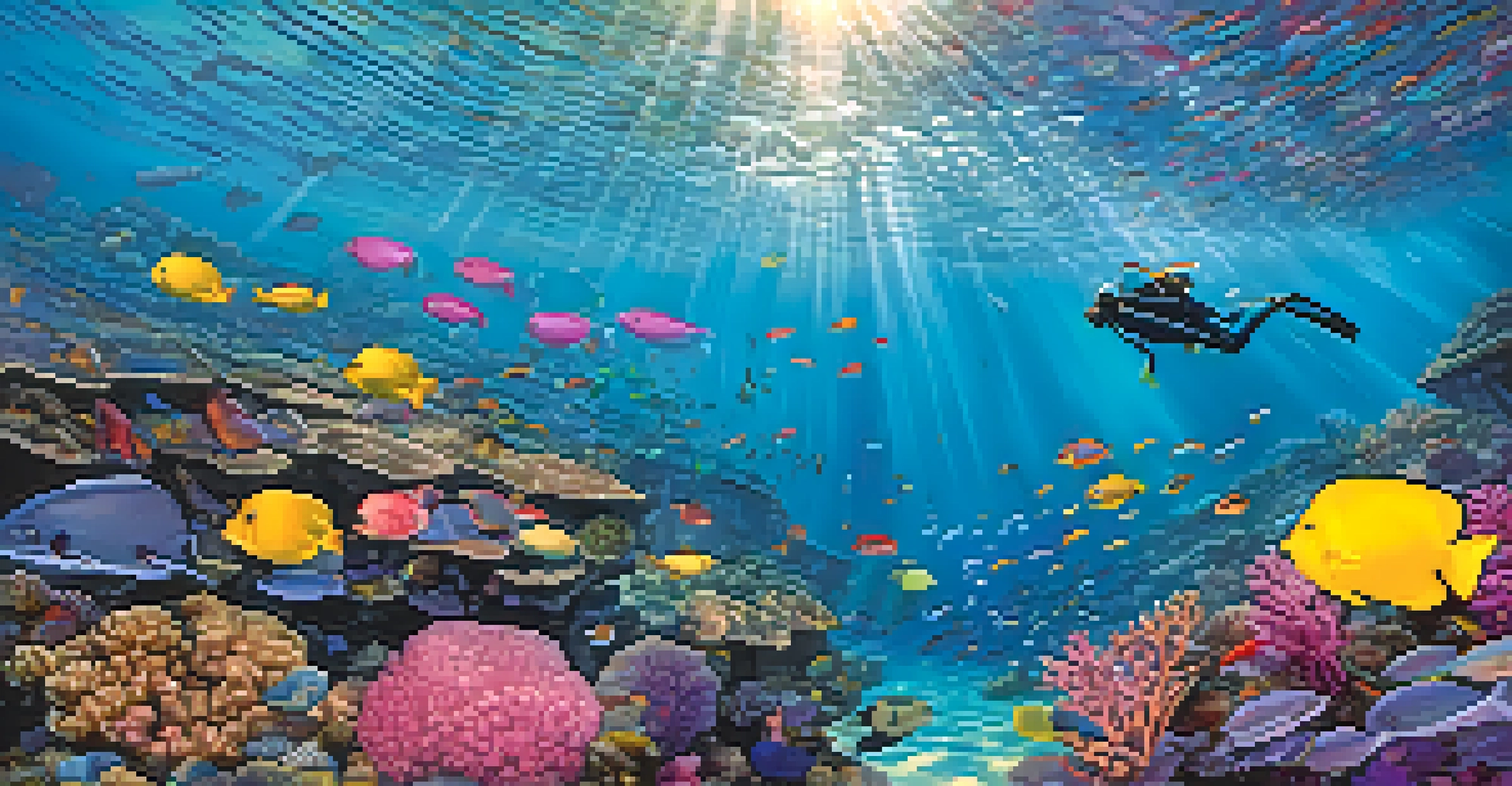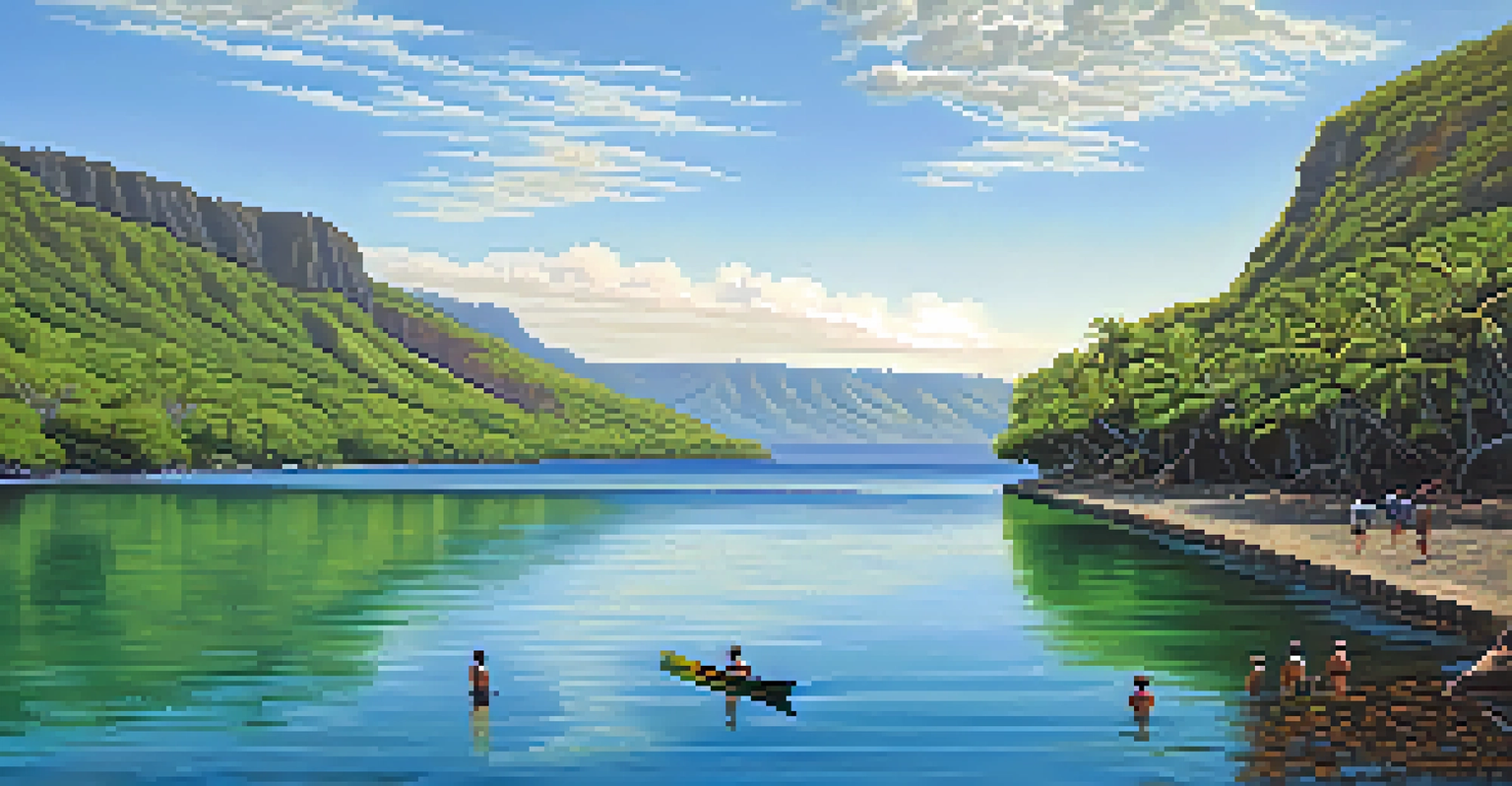A Beginner's Guide to Snorkeling in Hawaii's Waters

Understanding Snorkeling: What to Expect
Snorkeling is a fun way to explore underwater life without extensive training. It involves floating on the surface of the water while wearing a mask, snorkel, and fins. This allows you to breathe easily while observing the vibrant marine life beneath you.
The sea, once it casts its spell, holds one in its net of wonder forever.
In Hawaii, the water is generally warm and clear, making it an ideal place for beginners. You'll likely encounter colorful fish, coral reefs, and maybe even sea turtles! The experience can be both exhilarating and calming, as you glide through the water.
Before you dive in, it's important to familiarize yourself with the equipment. Getting comfortable with the mask and snorkel will enhance your underwater exploration and ensure a safe and enjoyable experience.
Choosing the Right Equipment for Snorkeling
Selecting the right equipment is crucial for a comfortable snorkeling experience. Most snorkeling gear includes a mask, snorkel, fins, and sometimes a wetsuit. You can rent gear from local shops, but investing in your own might be worthwhile for better fit and comfort.

When trying on a mask, ensure it seals well against your face without leaving marks. The snorkel should be easy to use, allowing you to breathe effortlessly. Fins come in different sizes, so choose a pair that fits snugly but allows for some movement.
Snorkeling Basics for Beginners
Snorkeling allows you to explore vibrant underwater life with minimal training using a mask, snorkel, and fins.
If you're planning to snorkel in cooler waters, consider a wetsuit for added warmth. Many rental shops offer wetsuits, but make sure to check for availability and sizes before your trip.
Top Snorkeling Spots in Hawaii
Hawaii is home to some of the world's best snorkeling locations. Popular spots include Hanauma Bay on Oahu, Molokini Crater on Maui, and Kealakekua Bay on the Big Island. Each location offers unique underwater landscapes teeming with marine life.
To escape and sit quietly on the beach – that’s my idea of paradise.
Hanauma Bay is particularly famous for its clear waters and diverse ecosystem. It's a protected marine life conservation area, making it a safe haven for snorkelers and wildlife alike. Remember to arrive early, as it can get crowded!
Molokini Crater, a crescent-shaped volcanic caldera, is accessible by boat and offers stunning underwater visibility. Kealakekua Bay is not only a snorkeling paradise but also rich in history, as it was the site of Captain Cook's landing. Each spot promises an unforgettable experience!
Safety Tips for Snorkeling in Hawaii
While snorkeling is generally safe, it's essential to be mindful of certain precautions. Always snorkel with a buddy, as this ensures you have someone to help in case of an emergency. Keep an eye on the weather and ocean conditions before heading out.
Pay attention to your surroundings, especially currents and waves. If you're feeling tired or uncomfortable, don't hesitate to take a break. Remember to stay hydrated and apply reef-safe sunscreen to protect both your skin and the marine environment.
Top Snorkeling Destinations
Hawaii boasts incredible snorkeling spots like Hanauma Bay and Molokini Crater, each offering unique marine experiences.
Lastly, familiarize yourself with the local wildlife. While it's tempting to touch or feed fish, it's best to observe from a distance to avoid disrupting their natural behavior. Respect the ocean, and it will reward you with incredible sights!
Understanding Marine Life and Ecosystems
Hawaii's underwater ecosystems are incredibly diverse, featuring colorful coral reefs and a wide variety of marine species. You'll likely see Hawaiian green sea turtles, also known as 'honu,' and many species of fish like the vibrant parrotfish. Learning about these creatures enhances your snorkeling experience.
Coral reefs are often referred to as the 'rainforests of the ocean' due to their rich biodiversity. They provide crucial habitats for many sea creatures. However, these delicate ecosystems are vulnerable, so it's important to practice responsible snorkeling and avoid touching or stepping on the coral.
Understanding the role of marine life in the ecosystem can deepen your appreciation for the underwater world. Each creature plays a part in maintaining the health of the ocean, and by observing them, you contribute to their conservation.
Best Times to Snorkel in Hawaii
Timing can significantly impact your snorkeling experience in Hawaii. The best months for snorkeling are typically from May to September when the waters are calmer and visibility is at its peak. During these months, you can enjoy warm temperatures and vibrant marine life.
Early mornings are often the best time to snorkel, as the water is usually calmer and less crowded. Additionally, wildlife is more active during these hours, giving you a better chance to see fish and other marine animals in their natural habitat.
Safety and Etiquette Tips
Always prioritize safety by snorkeling with a buddy and practicing respectful behavior towards marine life and their habitats.
However, always check local conditions and forecasts before heading out. Weather can change quickly in Hawaii, and it's essential to prioritize safety by snorkeling in optimal conditions.
Snorkeling Etiquette: Do's and Don'ts
Practicing good snorkeling etiquette ensures a positive experience for both you and the marine environment. Always respect wildlife by observing from a distance and never attempting to touch or feed them. This helps protect their natural behaviors and habitats.
Avoid standing on coral reefs or disturbing marine life. Even a small amount of contact can damage these delicate ecosystems, which take years to recover. Instead, float above the reef and admire its beauty without causing harm.

Additionally, be mindful of your surroundings and other snorkelers. Keep a safe distance from others, and communicate with your buddy to maintain a safe snorkeling experience. A little courtesy goes a long way in preserving Hawaii's stunning underwater world.